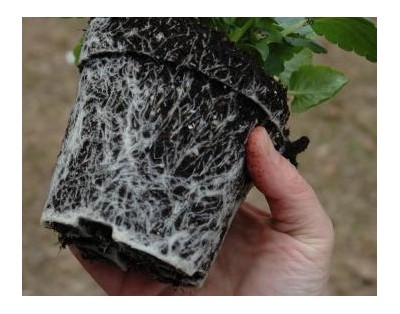Don't have an account?
Register NowYou have to add to cart at least 5 bottles or any program to make checkout.
- BlogDealing With Root Bound Plants
Dealing With Root Bound Plants
Published: January 28th, 2016
Categories:
Cannabis Cultivation
Naturally, cannabis always grows in the ground, allowing it fully spread its roots as it pleases. However, this is not always practical, and if you live in a particularly cold area of the world, or in a place where discretion is key, you often have to grow indoors using containers. Whilst growing cannabis in containers has its own advantages, it also puts your cannabis at risk of becoming root bound, so it is important to recognize the signs, and learn how to both prevent and fix it.
What Is Root Bound?
To put it simply, it means that the roots of your cannabis have outgrown the space of the container. The roots become “bound” as they run out of room to grow, and are constrained by the walls of your container. Even cannabis plants grown outdoors can become root bound if planted near a few impervious barriers – such as walls, pipes, or concrete.
Looking For The Symptoms – Assessing If Your Plants Are Root Bound
The following symptoms are all signs that your cannabis could potentially be root bound:
- Wilting
- Stretching
- Stunted growth
- Easy to overfeed and burn, even with low nutrient mixes.
- Requires watering more often than normal
- Slower and smaller bud growth than usual
- The plant container is warping, or being pushed out of shape (in the most severe cases).
If any of your cannabis plants are displaying these symptoms, and you fear that they may be root bound, the only way to truly tell is to take a look at the roots – which means you will have to remove your cannabis from its container - or check through holes from below, if possible.
Removing The Plant From Its Container
There are a couple of ways you can go about this, depending on how severely root bound your cannabis is. Whichever method you chose, make sure to be careful with your plant, and have a safe grip on it – you don’t want it to fall to the floor and become damaged when the container comes away.
The first thing to try is to simply see if your plant will come away from the container. To do this, carefully take a hold of the stem of your plant at its base – placing your hand flat on the top of the soil, with the stem in between your fingers can be a good way to do this. Turn the plant upside-down (in an area with plenty of room, so you don’t hit anything with it), and see if the container can be pulled off. If your cannabis is not badly root bound, it should come away pretty easily.
If you can’t simply pull the container off, try squeezing around it to loosen it up. If this doesn’t work, or if the container is made of a hard material, you can try taking a long thin knife and using its back edge to work your way around the edges of the container. Take great care here, as you want to cause as minimal damage as possible to the roots until you know what the situation is. Should your plant be so severely root bound that even the knife won’t work, or if you simply don’t want to try it, then the only option left in to break the container.
Checking The Roots
Now that you have your cannabis out of its container, take a look at the root ball. The roots should be running a tight circle around the shape of the container. Try digging your fingers into the outer layers in order to loosen them up.
In a worst case scenario, you will find that the root ball is too tight and developed to simply loosen them by hand. In this situation you can prune the roots to break the circular growth. Note, when you do this, you only want to be cutting the thin thread roots, not the thick tap roots. Cutting a tap root can have serious consequences on the health of your plant. To do so, take a sharp knife and make 2 or 3 incisions into the outside of the root ball. These incisions should cut from top to bottom, evenly spaced around it. This will help break the circular pattern of growth, and allow the roots to grow outwards when replanted.
Replanting
Now that your roots can grow outwards, it is time to replant in a container that has adequate room for expanded root growth. Fill your container with soil, dig a hole in it, and settle the root ball within – ensuring that you do not cover the top of the root ball in a thick layer of soil. It is important not to compact the soil too tightly, as this could prevent root penetration. A good way to ensure your soil is properly settled is to water it as you are adding layers. It's also a good opportunity to add in any root boosting/stimulating feeds you may have.
If you didn’t use any root stimulator, then feed your replanted cannabis with a weak fertiliser solution. Your cannabis is going to be quite sensitive for a few days, so it is also wise to turn down the intensity of your lights when growing indoors, or move your plants out of direct sunlight when growing outdoors. Cannabis can take anywhere between 1 day to 2 weeks to fully settle in, you will know it is time to return to normal lighting when you start seeing new growth aboveground.
The Best Solution Is Prevention
Although we have outlined how to deal with a root bound plant, the best way is to prevent it from ever happening in the first place. Ensure that the container you choose is big enough to accommodate your cannabis from the start, that way you will never have to worry with dealing with a root bound plant.





